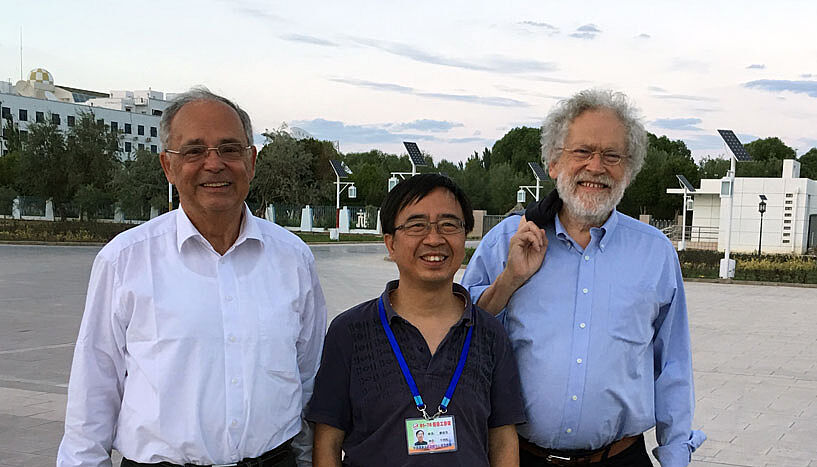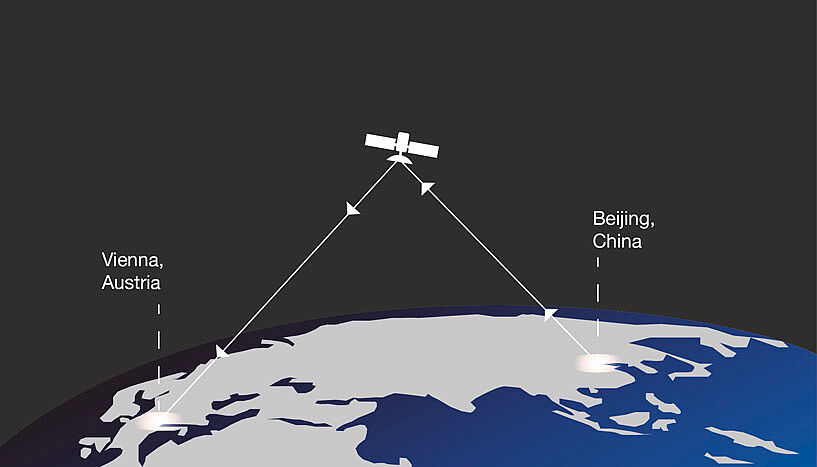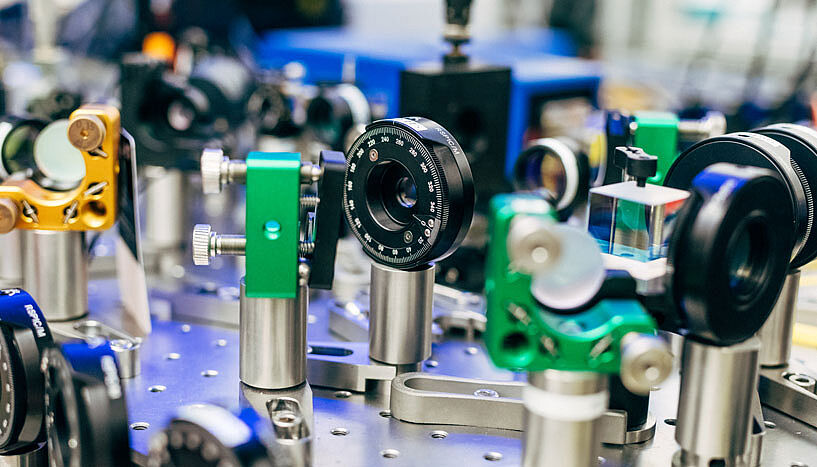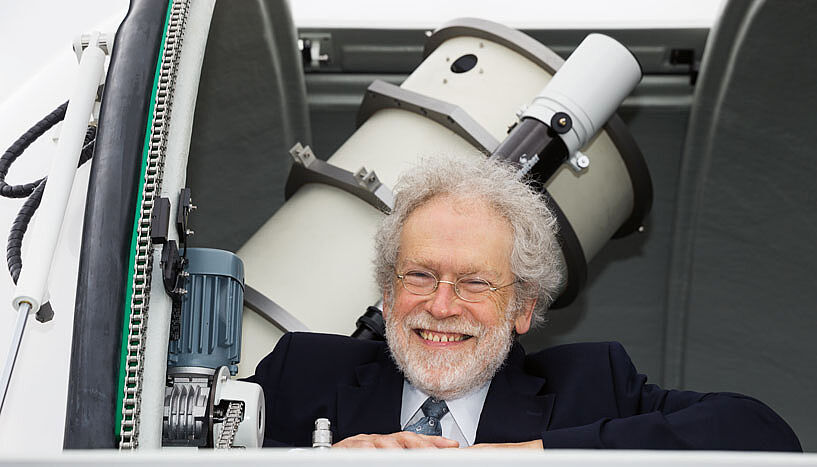First quantum satellite successfully launched
16. August 2016-
The launch of the Chinese research satellite "Micius" marks the dawn of a new era of global quantum communication. Built by researchers at the Chinese Academy of Sciences, the satellite will be the first to test the transfer of quantum information between space and Earth. Researchers at the Austrian Academy of Sciences and the University of Vienna are running the satellite’s European receiving stations. The launch was witnessed by the Rector of Vienna University Heinz W. Engl and by Anton Zeilinger, President of the Austrian Academy of Sciences. The project is under the scientific leadership of Jian-Wei Pan, Executive Vice-president of the Chinese Academy of Science's University of Science and Technology of China, also a foreign member of the Austrian Academy of Sciences.
After just five years of preparation, on 16 August 2016 at 1.40 a.m. local time the Chinese space station Jiuquan launched a special quantum satellite into orbit, from where the ca. 620-kg unit will send light quanta, so-called photons, which also can be entangled to receiving stations on Earth. For the first time, it will be possible to use quantum cryptography to transfer intercontinental messages several thousands of kilometres with complete security from eavesdropping.
The backbone are ground stations in China, where also the initial experiments will be conducted. In the framework of the project "Quantum Experiments at Space Scale" (QUESS) researchers in Vienna are overseeing up to five ground stations in Europe which will be used subsequently to establish for the first time intercontinental quantum communication. The Austrian contribution is a cooperative operation between the University of Vienna and the Austrian Academy of Sciences (OeAW), supported by the Federal Ministry for Science, Research and Economy.
Anton Zeilinger, quantum physicist and President of the Austrian Academy of Sciences expressed his delight with the successful launch of the QUESS mission. "Transporting highly sensitive research instruments into space is a complex and difficult undertaking. Hence all QUESS partners are extremely relieved and delighted by the successful launch of the rocket. This represents the first step on the way to worldwide quantum communication," explains Zeilinger.
Heinz W. Engl, Rector of the University of Vienna, is also pleased about the successful launch and is following the further development of the project with great interest. After all, quantum physics at the University of Vienna is one of Austrian research’s strongest suits. "Together with the OeAW we run the ground station in Vienna, the 'Hedy Lamarr Quantum Communication Telescope', on the roof of the Institute for Quantum Optics and Quantum Information, and have the Chinese Academy of Sciences on board as a project partner. Via this cooperation enabling basic research at the highest international level, we will do much to drive the quantum internet forward and raise communication around the world to a new level in the long term," says Engl.
Quantum teleportation from space
The successful launch of the mission also makes researchers confident about the coming challenges. The broadcast station’s arrival in space rings in a crucial phase of the project. The first task for "Micius" is to gain new insights into the quantum entanglement of particles. Dubbed "spooky action at a distance" by Albert Einstein, the term describes a unique connection between two particles that can take on an identical condition independent of the distance between them while being able, in theory, to transfer information over any distance. Such entanglement is used in both quantum cryptography and quantum teleportation.
Previously, Anton Zeilinger and his team had already been able to observe these phenomena in many experiments on ground up to a record distance of 144 kilometres. Longer distances on the Earth’s surface are impossible due to disturbances in the atmosphere and the Earth's curvature. The way around is going into space. From its orbit, the satellite will send entangled photons to the ground stations, including the "Satellite Laser Ranging Station" at the OeAW Space Research Institute in Graz, the "Hedy Lamarr Quantum Communication Telescope” at OeAW’s Institute for Quantum Optics and Quantum Information (IQOQI) in Vienna, and the Optical Ground Station (OGS) operated by the European Space Agency on the Canary Island of Tenerife. “Initial results could even be available within a year," hopes IQOQI researcher Thomas Scheidl.
Worldwide quantum communication
The project is bound to attract attention from beyond basic research however. The quantum physics phenomenon of entanglement has great potential, not least for quantum cryptography. In this respect, QUESS should provide valuable findings on the use and exchange of quantum cryptographic keys over previously unattainable distances. To this end, what are known as quantum keys are created between the satellite and the ground stations using photons. Any attempt at eavesdropping during key production would alter the condition of the photons and would thus immediately be noticed due to quantum entanglement. Quantum cryptography and quantum teleportation are two basic concepts of quantum communication. Hence, the researchers are hoping that their experiments will also contribute to the development of a future quantum internet.
"We can only guess the value for the future of the pioneering work connected to QUESS", comments Anton Zeilinger. A similar view is held by Jian-Wei Pan, scientific project leader and member of the Chinese Academy of Sciences. Pan, a former doctoral student of Anton Zeilinger’s at the Universities of Innsbruck and Vienna, considers the project to be "revolutionary". The successful launch into orbit certainly marks the first step towards this revolution in quantum physics.
Wissenschaftlicher Kontakt
emer. o. Univ.-Prof. Dr. Dr. h.c. Dr. h.c. Anton Zeilinger
Institut für Quantenoptik und Quanteninformation (IQOQI) Wien Österreichische Akademie der Wissenschaften und Quantenoptik, Quantennanophysik und Quanteninformation Universität Wien, Fakultät für PhysikUniversität Wien
1090 - Wien, Boltzmanngasse 3
+43-1-4277-512 01
anton.zeilinger@univie.ac.at
Rückfragehinweis
Dipl.-Soz. Sven Hartwig
Leitung Öffentlichkeit & KommunikationÖsterreichische Akademie der Wissenschaften
1010 - Wien, Dr. Ignaz Seipel-Platz 2
+43 1 51581-13 31
sven.hartwig@oeaw.ac.at
Mag. Veronika Schallhart
DLE ÖffentlichkeitsarbeitUniversität Wien
1010 - Wien, Universitätsring 1
+43-1-4277-17530
+43-664-8176793
veronika.schallhart@univie.ac.at
Downloads:
IMG_2646.JPG
Dateigröße: 1,68 MB
Bild_1_Teleskop_c_OEAW_Klaus_Pichler.jpg
Dateigröße: 12,28 MB
Bild_2_QUESS_Grafik_c_OEAW.jpg
Dateigröße: 246,16 KB
Bild_3_Versuchsanordnung_IQOQI_c_OEAW_Klaus_Pichler.jpg
Dateigröße: 16,64 MB
Bild_4_Anton_Zeilinger_c_IQOQI_Lois_Lammerhuber.jpg
Dateigröße: 5,19 MB





